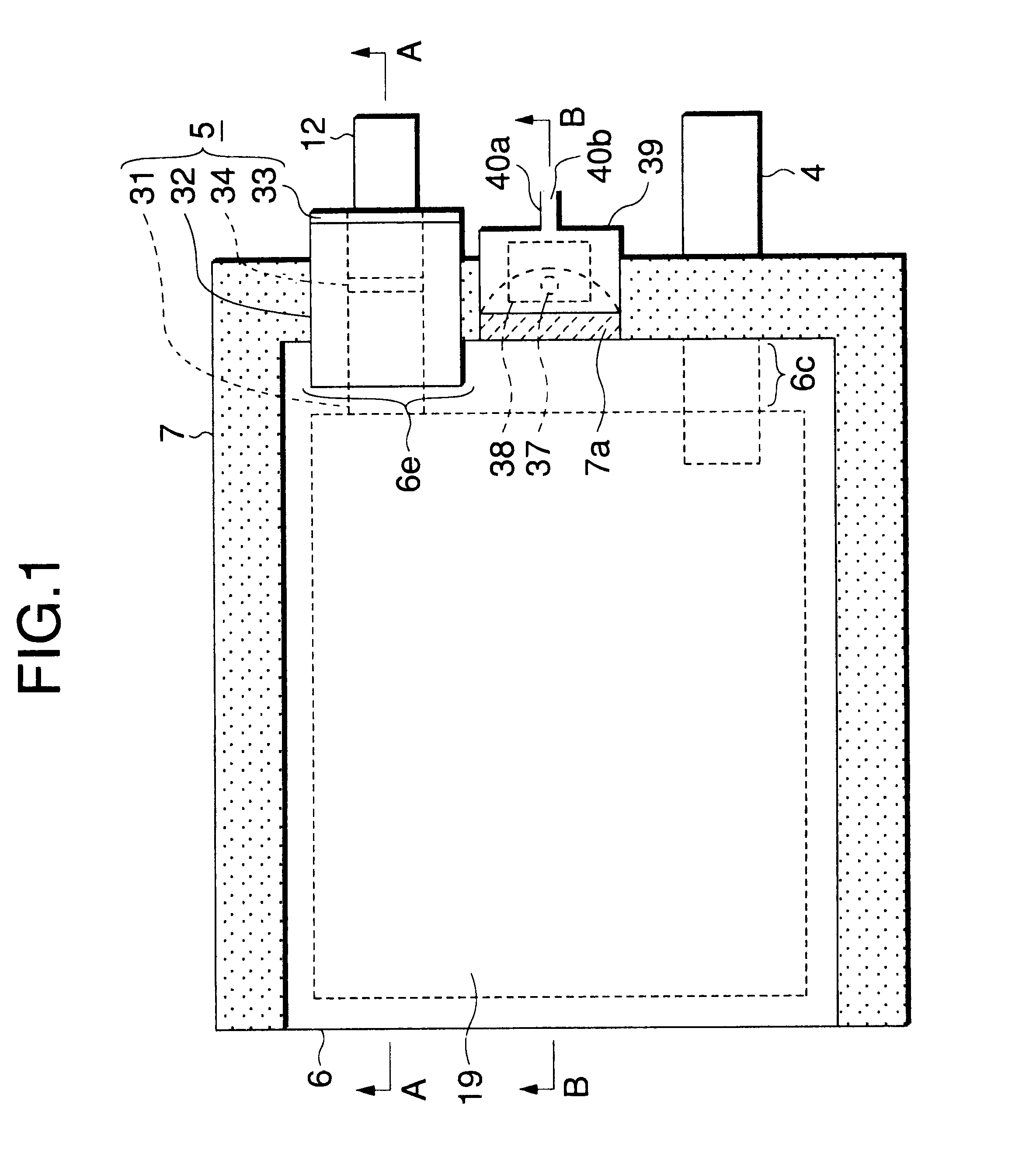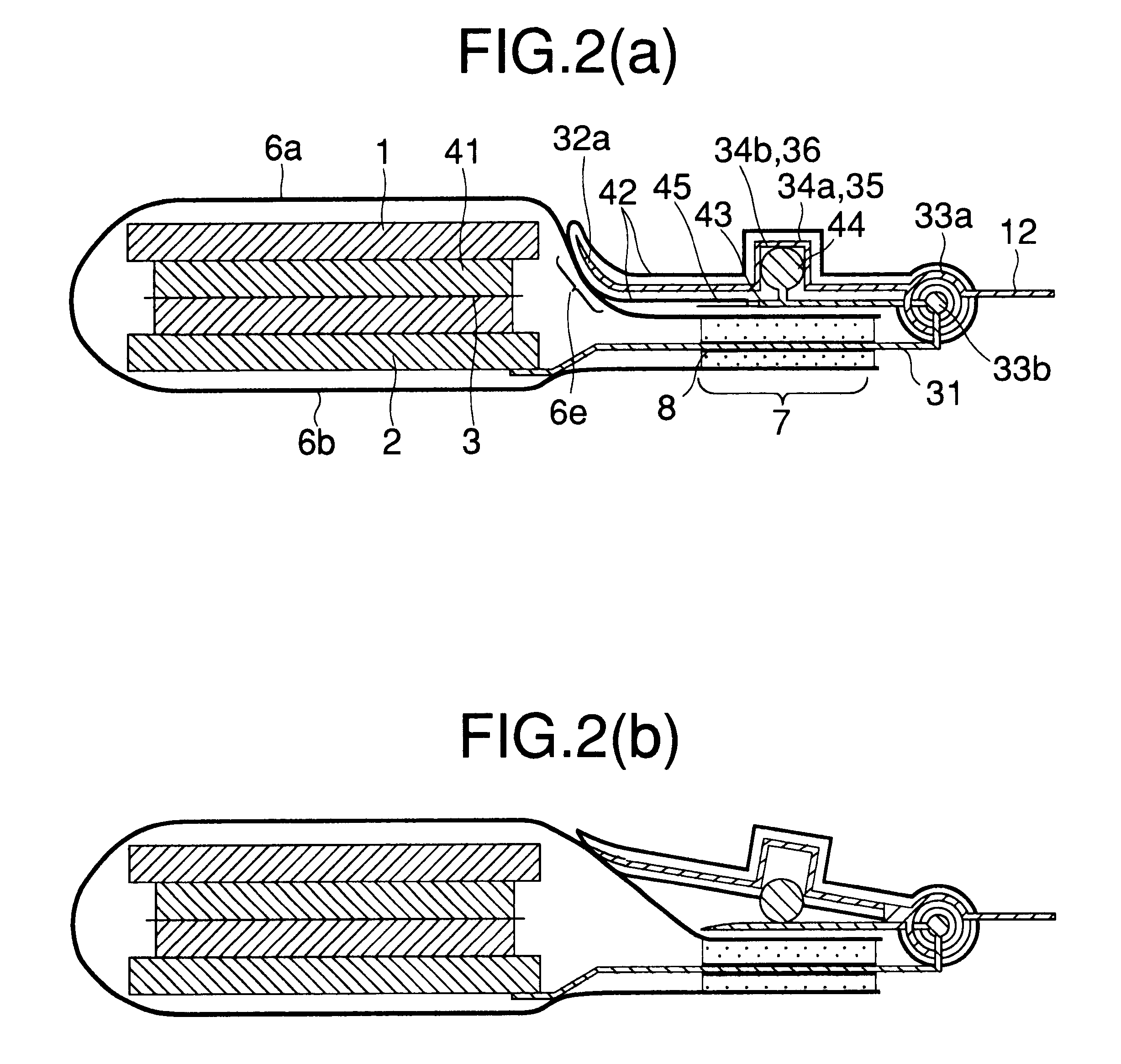Thin battery
a thin battery, light weight technology, applied in the direction of batteries, primary cell maintenance/servicing, non-aqueous electrolyte cells, etc., can solve the problems of affecting the operation of the battery, the inner pressure of the sealed portion rises, and the battery is not equipped with a safety mechanism for blocking current passage,
- Summary
- Abstract
- Description
- Claims
- Application Information
AI Technical Summary
Problems solved by technology
Method used
Image
Examples
embodiment 1
A thin battery according to Embodiment 1 of the present invention will be described in connection with the drawings. FIG. 1 is an entire schematic diagram as viewed from the top of a thin secondary battery equipped with a safety device according to Embodiment 1 of the present invention. FIG. 2 is a sectional view taken on line A--A of FIG. 1. FIG. 2(a) illustrates how the battery works during normal charging / discharging. FIG. 2(b) illustrates how the collector tab acts to block current passage when the inner pressure of the flexible encapsulating bag rises. In these drawings, the reference numerals 1 and 2 indicate a positive electrode and a negative electrode, respectively. The reference numerals 3 and 41 indicate a separator and an electrolyte layer, respectively. The separator 3 and the electrolyte 41 together form an ionically-conducting layer. The electrolyte 41 is any one of solid state, gel state electrolyte and material impregnated by liquid electrolyte. The reference numera...
embodiment 2
FIG. 4 concerns Embodiment 2 of the present invention and is a perspective view illustrating another embodiment of the collector tab with a current blocking function. While the groove 35 and rod 36 constituting the joint portion 34 is parallel to the hinge portion 33 in FIG. 2, the groove 35 and rod 36 are perpendicular to the hinge portion 33 in FIG. 4. The other basic structure of the embodiment of FIG. 4 is the same as that of FIG. 2 and thus will not be described herein.
embodiment 3
FIG. 5 concerns Embodiment 3 of the present invention and illustrates a further embodiment of the collector tab with a current blocking function. FIG. 5(a) is a diagram as viewed from the top of the collector tab with a current blocking function according to Embodiment 3 of the present invention. FIG. 5(b) is a sectional view taken on line A--A of FIG. 5(a) illustrating how the battery works during normal charging / discharging. FIG. 5(c) is a sectional view taken on line A--A of FIG. 5(a) illustrating how the collector tab acts to block current passage when the inner pressure of the encapsulating bag rises beyond the first predetermined value. In these drawings, the reference numeral 51 indicates a dislocation stop pin, the reference numeral 51a indicates a pin rod, the reference numeral 51b indicates a pin ball, and the reference numeral 52 indicates a dislocation stop round hole. While the joint 34 composed of the groove 35 and the rod 36 and the hinge 33 are used as fastening mean...
PUM
| Property | Measurement | Unit |
|---|---|---|
| Mass | aaaaa | aaaaa |
| Mass | aaaaa | aaaaa |
| Specific weight | aaaaa | aaaaa |
Abstract
Description
Claims
Application Information
 Login to View More
Login to View More - R&D
- Intellectual Property
- Life Sciences
- Materials
- Tech Scout
- Unparalleled Data Quality
- Higher Quality Content
- 60% Fewer Hallucinations
Browse by: Latest US Patents, China's latest patents, Technical Efficacy Thesaurus, Application Domain, Technology Topic, Popular Technical Reports.
© 2025 PatSnap. All rights reserved.Legal|Privacy policy|Modern Slavery Act Transparency Statement|Sitemap|About US| Contact US: help@patsnap.com



